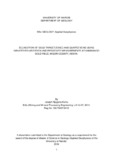| dc.contributor.author | Komu, Joseph N | |
| dc.date.accessioned | 2017-12-19T11:49:11Z | |
| dc.date.available | 2017-12-19T11:49:11Z | |
| dc.date.issued | 2016 | |
| dc.identifier.uri | http://hdl.handle.net/11295/102082 | |
| dc.description.abstract | A combined Induced Polarization and Resistivity survey was carried out in Kamwango area to delineate drill targets that would help plan an extended drill program. Gold potential in the area is evident by the extensive artisanal workings in the area. Given the high economic value of gold and its economic effect on the local community, there was need to initiate ways to efficiently define the mineralization.
IP and Resistivity methods, being some of the most effective geophysical methods for gold exploration, were used to map possible mineralization, employing advanced processing techniques to enhance interpretation, focusing the exploration program and minimizing risks before deciding to drill.
The research employed IP and Resistivity survey equipment to acquire: 1. Gradient data showing IP and Resistivity anomalous zones, 2. Pole-dipole data acquired over revealed gradient anomalies and tracing the anomalous zones to depth. The data were then processed using Oasis Montaj software and inverted using Res2dinv software to facilitate interpretation.
Six possible mineralized zones were identified from the study area, the zones are quite extensive, trend NW-SE and continuous as they extend from one survey line to the next. The NW-SE trend is consistent with the general trend of geological formations and structural formlines. The zones are most prominent in the Kamwango shear zone and the agglomerates with some zones occurring near the contact between the agglomerate and the Kamwango shear zone and another zone near the agglomerates and vesicular lava contact. The fact that one of the zones occurs in the area where previous boreholes were drilled by the license holder shows that the methods were a success and quite useful in the survey of this type of gold mineralization. A total of nine boreholes were proposed for follow-up drilling from the interpreted results. | en_US |
| dc.language.iso | en | en_US |
| dc.publisher | University of Nairobi | en_US |
| dc.rights | Attribution-NonCommercial-NoDerivs 3.0 United States | * |
| dc.rights.uri | http://creativecommons.org/licenses/by-nc-nd/3.0/us/ | * |
| dc.subject | Delineation Of Gold Target Zones | en_US |
| dc.title | Delineation Of Gold Target Zones And Quartz Veins Using Induced Polarization And Resistivity Measurements At Kamwango Gold Field, Migori County, Kenya. | en_US |
| dc.type | Thesis | en_US |



